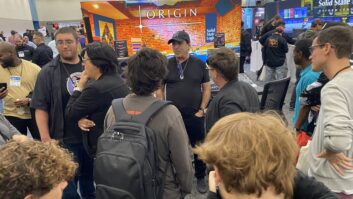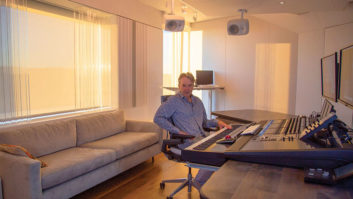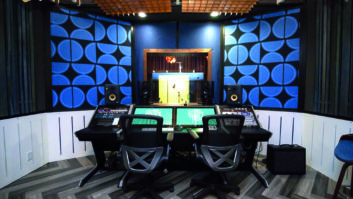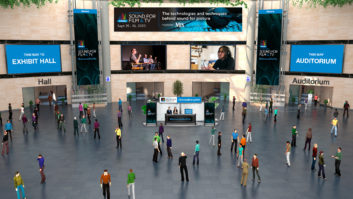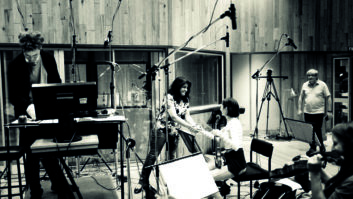Sopranos music editor Kathryn Dayak worked with series creator David Chase and producer Martin Bruestle on Northern Exposure before taking the job of music editor on Chicago Hope. When she rejoined the team, signing on to The Sopranos for the first season, she found herself in a unique position: music editor on a show with no music composer.
“I think we’re likeminded on this show, in that David, Martin and I all feel that underscore, as you usually see it in films and TV, can be a little over-the-top and manipulative,” Dayak says. “As in: ‘Here’s a cue that’s sad, so we’d like for you to feel sad.’ Sometimes there’s much more impact in not trying to tell people how to feel. So there’s that aspect of the show. Then, of course, there’s the whole reality side, like what music would you hear if you were in a pizza parlor in New Jersey?”
Making licensed music fit a scene can be a complicated process, requiring both technical skill and taste, and involving changes in structure, tempo and timing. For example, take one of those pizza parlor scenes. “Instrumental bridges tend to be friendly to dialog,” Dayak notes, “versus the chorus, where if you start listening too much to the music, you might miss the dialog. We just used ‘Ain’t Talkin’ About Love’ by Van Halen as a source cue in a pizza parlor. It worked with the locale, and we placed it in a way that when the characters enter the parlor, you hear some vocals so you get what the song is. As they cross and began their dialog, we have it go into an instrumental bridge — now your mind is on the dialog and you don’t pay attention to David Lee Roth. Then, we brought in some vocals at the end of the scene when the dialog is finished.”
Any time music appears in a scene, no matter how briefly or how distant, it falls under the music editor’s domain. “Another thing we do is use musical instruments as walla,” continues Dayak. “We’ve had scenes where there’s a violin playing scales in the back of the auditorium. In the funeral scene we just finished for the second new episode, there’s an organ playing. We built the organ music on two separate tracks so that when the actors are in the large room we can play it more fully, but when there’s a cut to the back room behind the walls, it can be muffled, implying that it’s coming from the other room.
“Also, we like to add little reality bites,” she says. “For example our car-bys: If you see cars and you hear rap music coming out of the car, we’ve put a piece in. Or in the dorm room scenes, the thump-thump of bass drum through the walls — you may not even recognize what piece it is.”
Since last season, Dayak has been conveniently set up in the same offices as the picture editors. “That’s probably unusual for most TV shows,” she admits. “But we’ve found it valuable, because when the editors are putting cuts together, they might request that I cut a piece of music for them and place it. Then they might change the picture a bit and give it back to me to adjust. We have three editors set up with their assistants, myself and Martin, and we’re just two blocks from the dub stage. If something comes up, we can address it and be back to the stage in five minutes.”
Dayak has been working in Pro Tools for five years and believes that the system has helped her develop her role in the creative process. “When I started my first jobs as a music editor, it was much less about doing any actual cutting,” she relates, “and much more about the secretarial chores of working with a composer. With the advent of Pro Tools, the job has become much more creative. And on a show like Sopranos, where there isn’t a composer, it’s a dream come true. It’s great to work with the music digitally and actually cut it to picture as opposed to, ‘Okay, start the cue at one second, end the cue at five seconds.’”
While all of the music Dayak uses starts out on 2-tracks, it often expands to many more. “I may have gone out 10, 12 or more tracks to achieve the edit that I like,” she explains. “Even cues that sound very simplistic may be out 20 or 24 tracks to make them work tempo-wise, although in the end I’ll bus them down to two tracks to give them to our music mixer.”
Currently music gets delivered to the dubbing stage on 8-track DA-88, though each episode might make use of three or four separate tapes running in sync. Besides her 24-bit Pro Tools system, other equipment Dayak relies upon includes various musical instruments, which she occasionally uses to add textures to scenes, and the Line 6 Pod, for musical instrument processing. The music itself comes from many sources: Dayak and Bruestle’s personal music collections, and of course many cuts are suggested by series creator/executive producer David Chase, who, according to Dayak, has a personal music library and a knowledge of music that are both “immense.”
“Sometimes specific songs are even written into the script,” she explains. “Or sometimes David will just suggest that we keep a song in mind to be used at some point in some episode. Though we all contribute our musical suggestions, in the end it’s David who makes the final approval on what song goes in a scene.”
Although no specially composed music has been used so far on Sopranos, the sonic envelope of existing songs is getting some pushing, and for 2001’s opening episode, Dayak did some particularly creative mixing. “I had a call from Martin who said that David wanted to know if I could combine ‘Every Breath You Take’ by the Police with Henry Mancini’s ‘Peter Gunn.’
“I loaded both songs into Pro Tools, started experimenting and found that they were actually very related in key, and close in tempo — close enough that I could work with them,” she recalls. “Instead of making a sound collage, I tried to create a piece of music and came up with some demos that I sent to David, who suggested that we try using them as score in the first show. This turned out to be a kind of theme and variations. The first cue acts as an exposition to the audience, displaying what we are doing in combining these two pieces, and the subsequent cues are variations, all derived from the two pieces.
“I think David, Martin and I very much complement each other,” she concludes. “I really like contributing to selecting music for the show but it’s so great to work as a team on the music, because each of us has something different to offer. Or David or Martin can suggest a song and give it to me, then I can come into play and show them a thousand different ways that it could exist in the scene. Does the instrumental bridge fall over the dialog? Or, maybe we tag the end of the scene with four words from a chorus that are very meaningful. Because besides the choice of the song, it really makes a difference in how the song is prepared, and how it’s placed.”
